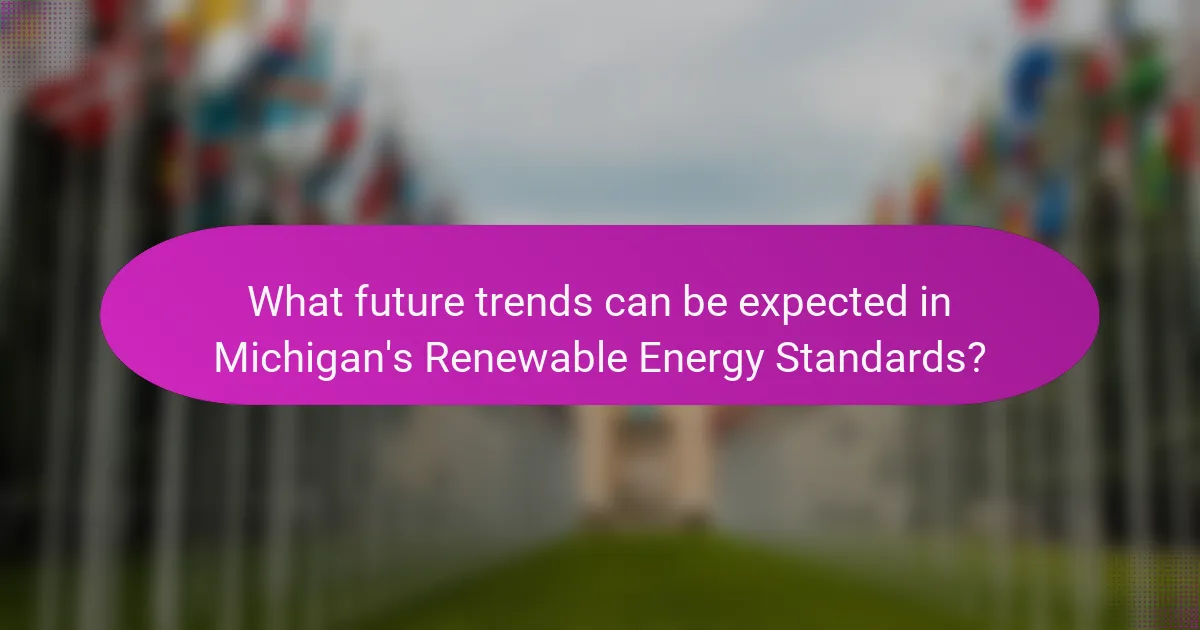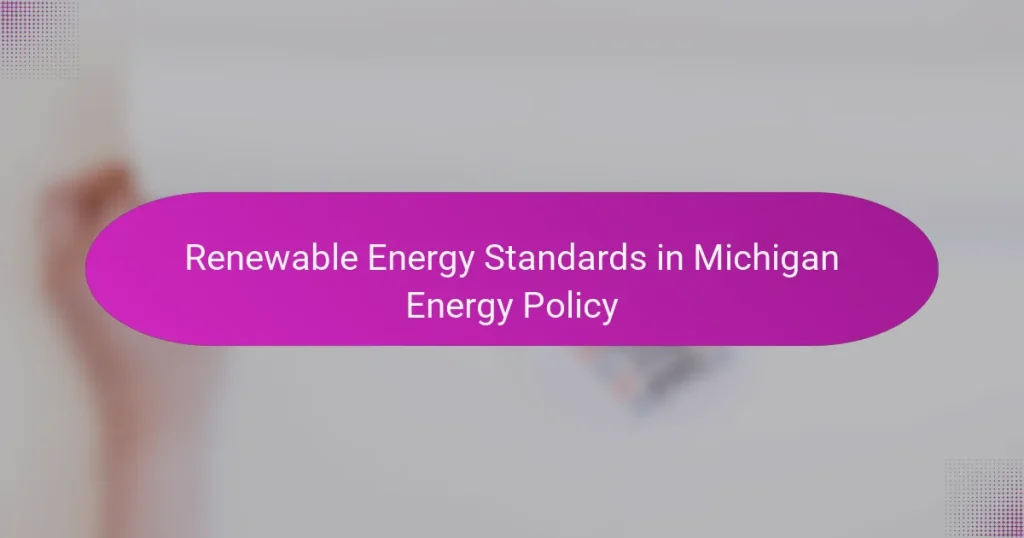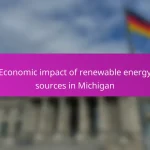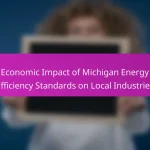
What are Renewable Energy Standards in Michigan Energy Policy?
Renewable Energy Standards in Michigan Energy Policy mandate a specific percentage of electricity to be generated from renewable sources. These standards aim to promote the use of renewable energy and reduce greenhouse gas emissions. The current target requires utilities to obtain at least 15% of their energy from renewable sources by 2021. This policy encourages the development of wind, solar, and other renewable energy projects within the state. Michigan’s Renewable Portfolio Standard (RPS) is designed to diversify the energy mix and enhance energy security. Compliance is monitored by the Michigan Public Service Commission, ensuring that utilities meet their renewable energy obligations. The standards contribute to job creation in the renewable energy sector and stimulate economic growth.
Why are Renewable Energy Standards important for Michigan?
Renewable Energy Standards are important for Michigan because they promote the use of clean energy sources. These standards help reduce greenhouse gas emissions. They also encourage investment in renewable technologies. In 2020, Michigan set a goal of achieving 50% renewable energy by 2030. This shift supports job creation in the renewable sector. Additionally, it enhances energy security by diversifying energy sources. Renewable Energy Standards also help stabilize energy prices over time. Overall, they play a crucial role in Michigan’s transition to a sustainable energy future.
What goals do these standards aim to achieve?
The goals of renewable energy standards in Michigan energy policy aim to increase the use of renewable energy sources. These standards promote energy efficiency and reduce reliance on fossil fuels. They also aim to decrease greenhouse gas emissions and improve air quality. By setting specific targets, the standards encourage investment in renewable technologies. This leads to job creation in the renewable energy sector. Additionally, they aim to enhance energy independence and security for the state. Overall, the standards contribute to a sustainable energy future for Michigan.
How do Renewable Energy Standards impact the environment?
Renewable Energy Standards (RES) positively impact the environment by promoting the use of clean energy sources. They encourage the reduction of greenhouse gas emissions. By increasing renewable energy generation, RES help decrease reliance on fossil fuels. This shift leads to improved air quality and reduced water pollution. For instance, according to the U.S. Environmental Protection Agency, transitioning to renewable energy can cut carbon dioxide emissions significantly. Additionally, renewable energy sources, such as wind and solar, require less water than traditional energy sources. This conservation of water resources further benefits the environment. Overall, RES support sustainable practices that protect ecosystems and public health.
What entities are involved in establishing these standards?
The entities involved in establishing renewable energy standards in Michigan include state government agencies, utility companies, and regulatory bodies. The Michigan Public Service Commission (MPSC) plays a key role in setting these standards. Additionally, the Michigan Legislature enacts laws that shape renewable energy policies. Non-governmental organizations and advocacy groups also influence these standards through lobbying and public engagement. Collaboration among these entities ensures that renewable energy standards are comprehensive and effective.
Who are the key stakeholders in Michigan’s energy policy?
The key stakeholders in Michigan’s energy policy include state government agencies, utility companies, environmental organizations, and consumer advocacy groups. State government agencies, such as the Michigan Public Service Commission, regulate energy markets and set policy frameworks. Utility companies, like DTE Energy and Consumers Energy, are responsible for energy generation and distribution. Environmental organizations advocate for sustainable practices and renewable energy initiatives. Consumer advocacy groups represent the interests of residents and businesses regarding energy costs and reliability. These stakeholders influence the development and implementation of renewable energy standards in Michigan.
What roles do state agencies play in implementing these standards?
State agencies play a crucial role in implementing renewable energy standards in Michigan. They are responsible for developing regulations that align with these standards. Agencies also oversee compliance and ensure that energy providers meet required benchmarks. Furthermore, they facilitate the integration of renewable energy sources into the existing grid. State agencies provide technical assistance and guidance to stakeholders involved in renewable energy projects. They also engage in public outreach to promote awareness of renewable energy initiatives. Additionally, agencies collect data to monitor progress and assess the impact of renewable energy standards. This structured approach helps ensure that Michigan meets its renewable energy goals effectively.
How do Renewable Energy Standards influence energy production in Michigan?
Renewable Energy Standards (RES) significantly influence energy production in Michigan by mandating a specific percentage of energy to come from renewable sources. As of 2023, Michigan’s RES requires utilities to obtain at least 15% of their energy from renewable sources. This requirement has led to increased investments in wind and solar energy projects across the state.
Utilities are incentivized to develop renewable energy facilities to comply with these standards. This shift has resulted in a growing capacity for renewable energy, with Michigan generating over 25% of its electricity from renewable sources in recent years. The standards also promote technological advancements and job creation in the renewable sector.
Furthermore, RES contribute to reducing greenhouse gas emissions, aligning with broader environmental goals. Overall, Renewable Energy Standards play a crucial role in shaping Michigan’s energy landscape, driving the transition towards a more sustainable energy future.
What types of renewable energy sources are promoted?
The types of renewable energy sources promoted include solar, wind, biomass, and hydropower. Solar energy is harnessed through photovoltaic cells and solar thermal systems. Wind energy is generated using turbines that convert wind movement into electricity. Biomass energy comes from organic materials, such as plant and animal waste, used for fuel. Hydropower utilizes flowing water to produce energy, often through dams. According to the Michigan Renewable Energy Standard, these sources aim to increase the state’s renewable energy production. The policy targets a 15% renewable energy supply by 2021, promoting sustainability and reducing carbon emissions.
How do these standards affect traditional energy sources?
Renewable energy standards impact traditional energy sources by mandating a shift towards cleaner alternatives. These standards often require utilities to increase the percentage of energy generated from renewable sources. As a result, reliance on fossil fuels decreases over time. Traditional energy sources face reduced demand due to these regulations. This shift can lead to economic challenges for fossil fuel industries. In Michigan, the renewable portfolio standard aims for 15% renewable energy by 2021. Compliance with these standards can drive innovation in energy efficiency and technology. Overall, traditional energy sources must adapt to remain competitive in a changing energy landscape.

What challenges does Michigan face in meeting Renewable Energy Standards?
Michigan faces several challenges in meeting Renewable Energy Standards. One major challenge is the aging energy infrastructure. Much of Michigan’s current energy grid requires significant upgrades to accommodate renewable sources. Another challenge is the reliance on fossil fuels, which still dominate the energy mix. This reliance complicates the transition to renewable energy sources. Additionally, there are regulatory hurdles that slow down the implementation of new renewable projects. These regulations can create delays and increase costs for developers. Furthermore, public acceptance and local opposition can hinder the development of renewable energy projects. Lastly, securing sufficient funding for renewable initiatives remains a significant barrier. These challenges collectively impact Michigan’s ability to meet its renewable energy goals effectively.
What are the barriers to achieving renewable energy goals?
Barriers to achieving renewable energy goals include regulatory challenges, financial constraints, and technological limitations. Regulatory challenges arise from inconsistent policies and lack of support at various government levels. Financial constraints often stem from high initial investment costs and limited access to funding. Technological limitations can include insufficient infrastructure and reliance on outdated energy systems. According to the Michigan Energy Policy, these barriers hinder the transition to cleaner energy sources. Reports indicate that states with clear and stable policies see faster renewable energy adoption.
How does funding impact the implementation of these standards?
Funding directly influences the implementation of renewable energy standards in Michigan energy policy. Adequate financial resources enable the development of necessary infrastructure. This includes the construction of renewable energy facilities and the installation of technology. Insufficient funding can lead to delays and reduced project scopes. Additionally, funding affects research and development efforts for innovative solutions. Grants and incentives can encourage private investment in renewable projects. Public funding can also support community education and outreach initiatives. Studies indicate that states with higher funding levels see faster progress in meeting renewable energy goals.
What regulatory hurdles exist for renewable energy projects?
Regulatory hurdles for renewable energy projects include complex permitting processes and inconsistent state policies. These hurdles can delay project timelines significantly. Local zoning laws may impose additional restrictions, complicating project development. Interconnection standards can vary, affecting how renewable energy systems connect to the grid. Financial incentives may also be subject to changes, impacting project viability. Furthermore, compliance with environmental regulations can add layers of complexity. Stakeholder opposition can arise, leading to public hearings and additional scrutiny. Overall, these regulatory challenges can hinder the growth of renewable energy initiatives.
How does public opinion affect Renewable Energy Standards in Michigan?
Public opinion significantly influences Renewable Energy Standards in Michigan. When citizens express strong support for renewable energy, policymakers are more likely to enact favorable standards. Surveys indicate that a majority of Michiganders favor increasing the use of renewable energy sources. This public sentiment pressures legislators to advocate for ambitious renewable energy goals. Additionally, grassroots movements and advocacy groups mobilize community support. They often campaign for policies that align with public preferences. As a result, public opinion shapes legislative agendas and regulatory frameworks. This dynamic ensures that Renewable Energy Standards reflect the values and priorities of Michigan residents.
What role does community engagement play in energy policy?
Community engagement plays a crucial role in energy policy by fostering public participation and collaboration. It helps ensure that energy policies reflect the needs and values of the community. Engaging local stakeholders can lead to more effective and equitable energy solutions. Research shows that inclusive decision-making processes enhance public trust in energy initiatives. For example, the Michigan Public Service Commission emphasizes stakeholder involvement in developing renewable energy standards. This approach has been linked to increased support for energy projects and better alignment with community priorities.
How can public awareness be improved regarding renewable energy?
Public awareness regarding renewable energy can be improved through education, community engagement, and targeted campaigns. Educational programs in schools can teach students about the benefits of renewable energy. Community workshops can provide hands-on experiences and discussions. Social media campaigns can share success stories and statistics about renewable energy adoption. Collaborations with local businesses can promote renewable energy initiatives. Public events can showcase renewable technologies. Research indicates that informed communities are more likely to support renewable energy policies. According to a 2021 survey by the Michigan Energy Office, 75% of residents support increased use of renewable energy when informed about its benefits.

What future trends can be expected in Michigan’s Renewable Energy Standards?
Michigan’s Renewable Energy Standards are expected to evolve towards more aggressive targets for renewable energy generation. The state aims to achieve a 50% renewable energy supply by 2030, reflecting a commitment to sustainability. This shift aligns with national trends towards decarbonization and energy independence.
Additionally, there is an increasing focus on integrating energy storage solutions to support renewable energy sources. The state legislature is likely to consider policies that promote energy efficiency alongside renewable generation.
In 2021, Michigan’s Public Service Commission reported a significant rise in renewable energy capacity, indicating a positive trend. Furthermore, advancements in technology are expected to lower costs and enhance the viability of renewable resources.
Overall, these trends suggest a comprehensive approach to enhancing Michigan’s energy landscape while meeting environmental goals.
How might technology advancements influence these standards?
Technology advancements can significantly influence renewable energy standards in Michigan. Innovations in energy storage, such as lithium-ion batteries, enhance grid reliability. Improved solar panel efficiency increases energy output, making solar more competitive. Wind turbine technology advancements lead to higher energy capture at lower wind speeds. Smart grid technologies enable better energy management and integration of renewable sources. Data analytics and artificial intelligence optimize energy consumption patterns. These advancements can drive policy updates to reflect improved capabilities and economic viability.
What innovations are on the horizon for renewable energy in Michigan?
Innovations on the horizon for renewable energy in Michigan include advancements in solar technology, energy storage solutions, and offshore wind projects. Michigan is focusing on enhancing solar panel efficiency through new materials and designs. Energy storage innovations, such as advanced battery systems, are being developed to better manage intermittent renewable sources. Additionally, the state is exploring offshore wind farms, which could significantly increase its renewable energy capacity. According to the Michigan Energy Innovation Business Council, these initiatives aim to meet the state’s goal of 50% renewable energy by 2030.
How could changes in federal policy impact state standards?
Changes in federal policy can significantly impact state standards for renewable energy. Federal mandates can establish minimum requirements that states must follow. For example, the federal government may set emissions targets that require states to adopt stricter renewable energy standards. This can lead to increased investment in renewable technologies at the state level. Additionally, federal funding and incentives can encourage states to align their standards with national goals. Historical instances, such as the Clean Power Plan, illustrate how federal initiatives prompted states to revise their renewable energy policies. Therefore, shifts in federal policy often drive changes in state-level renewable energy standards.
What practical steps can individuals take to support Renewable Energy Standards?
Individuals can support Renewable Energy Standards by adopting energy-efficient practices. They can reduce energy consumption by using LED bulbs and Energy Star appliances. Installing solar panels is another effective step. This action directly contributes to renewable energy generation. Participating in community solar programs also helps. It allows individuals to invest in renewable energy without installing solar panels on their property. Advocating for renewable energy policies is crucial too. Engaging with local representatives can influence energy legislation. Lastly, educating others about the benefits of renewable energy fosters community support. These practical steps collectively strengthen the push for Renewable Energy Standards.
How can residents contribute to renewable energy adoption in Michigan?
Residents can contribute to renewable energy adoption in Michigan by participating in community solar programs. These programs allow residents to invest in or subscribe to solar energy projects without installing panels on their property. Additionally, residents can advocate for local policies that support renewable energy initiatives. Engaging in educational campaigns about the benefits of renewable energy also helps raise awareness. According to the Michigan Public Service Commission, renewable energy usage has increased significantly, indicating a positive trend towards adoption. Furthermore, residents can reduce their energy consumption through efficiency measures, which complements renewable energy efforts.
What resources are available for individuals interested in renewable energy?
Individuals interested in renewable energy can access various resources. These include online courses, government programs, and local organizations. Websites like Coursera and edX offer courses on renewable energy technologies. The U.S. Department of Energy provides information on incentives and funding opportunities. The Michigan Energy Office offers resources specific to Michigan residents. Local non-profits often host workshops and informational sessions. Additionally, community solar programs allow individuals to invest in renewable energy collectively. These resources support education and engagement in renewable energy initiatives.
Renewable Energy Standards in Michigan Energy Policy are regulations that mandate a specific percentage of electricity generation from renewable sources, aiming to promote clean energy and reduce greenhouse gas emissions. Currently, utilities are required to obtain at least 15% of their energy from renewable sources, with a goal of reaching 50% by 2030. The article discusses the importance of these standards, their environmental impact, the key stakeholders involved, and the challenges Michigan faces in implementing them. Additionally, it highlights the role of technology advancements and public opinion in shaping future renewable energy policies.


